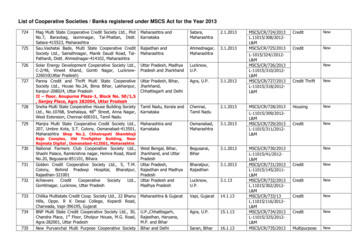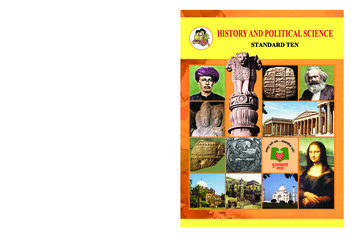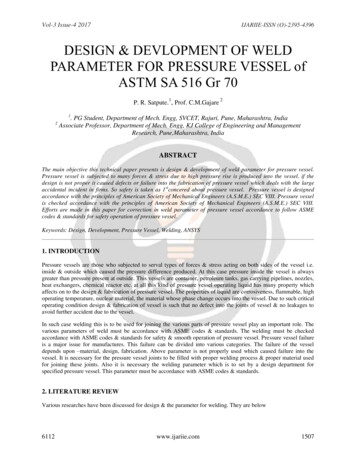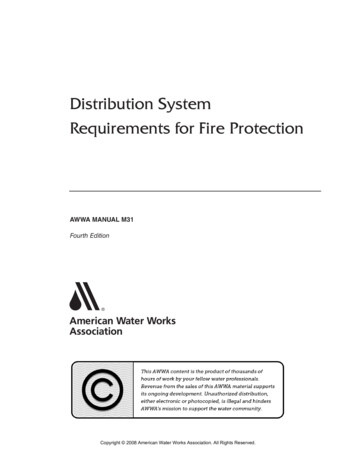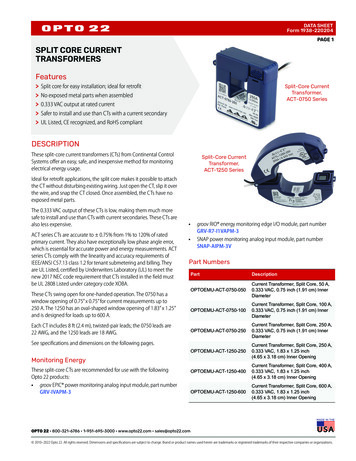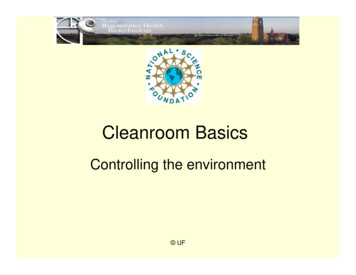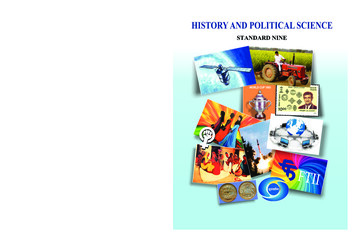
Transcription
HISTORY AND POLITICAL SCIENCESTANDARD NINEMaharashtra State Bureau of Textbook Production andCurriculum Research, Pune.B{Vhmg d amÁ emñÌ B. 9 dr (B§J«Or mÜ )54.00
The Coordination Committee formed by GR No. Abhyas - 2116/(Pra.Kra.43/16) SD - 4Dated 25.4.2016 has given approval to prescribe this textbook in its meeting held on 3.3.2017History andPolitical ScienceStandard NineMaharashtra State Bureau of Textbook Production andCurriculum Research, Pune.The QR Code given alongside and on otherpages can be scanned with a smartphone,which leads to link/s (URL) useful for theteaching/learning of this textbook.
First Edition : 2017 MaharashtraState Bureau of Textbook Production and CurriculumResearch, Pune - 411 004.The Maharashtra State Bureau of Textbook Production and CurriculumResearch reserves all rights relating to the book. No part of this bookshould be reproduced without the written permission of the Director,Maharashtra State Bureau of Textbook Production and CurriculumResearch, ‘Balbharati’, Senapati Bapat Marg, Pune 411004.History Subject CommitteeAuthorsCartographerDr Sadanand More, ChairmanShri. Mohan Shete, MemberShri. Pandurang Balkawade, MemberShri. Bapusaheb Shinde, MemberShri. Balkrishna Chopde, MemberShri. Prashant Sarudkar, MemberShri. Mogal Jadhav, Member-SecretaryDr Ganesh RautDr Vaibhavi PalsuleShri. Ravikiran JadhavCover and IllustrationsScrutinyShri. Mukim ShaikhDr Ganesh RautTranslationProf. Arati KhatuDr Padma MehtaShri. Sushrut KulkarniTypesettingDTP Section, BalbharatiPaperCivics Subject CommitteeCoordination70 GSM CreamwoveDr Shrikant Paranjape, ChairmanProf. Sadhana Kulkarni, MemberDr Mohan Kashikar, MemberShri. Vaijnath Kale, MemberShri. Mogal Jadhav, Member-SecretaryMogal Jadhav,Special Officer,History and CivicsPrint OrderVarsha SarodeSubject Assistant,History and CivicsHistory and Civics Study GroupShri. Rahul PrabhuDr Raosaheb ShelkeShri. Sanjay VazarekarShri. Mariba ChandanshiveShri. Subhash RathodShri. Santosh ShindeSmt Sunita DalviDr Satish ChapleProf. Shivani LimayeShri. Vishal KulkarniShri. Bhausaheb UmateShri. Shekhar PatilDr Nagnath YevaleShri. Sanjay MehtaShri. Sadanand DongreShri. Ramdas ThakarShri. Ravindra PatilDr Ajit ApteShri. Vikram AdsulDr Mohan KhadseSmt Rupali GirkarSmt Shivkanya KaderkarDr Minakshi UpadhyayShri. Gautam DangeSmt Kanchan KetkarDr Vyankatesh KharatSmt Shivkanya PatveShri. Ravindra JindeDr Anil SingareDr Prabhakar LondheN/PB/2017-18/50,000PrinterM/s. Shree Samarth QualityWorks, Navi MumbaiCoordinationDhanavanti HardikarAcademic Secretary for LanguagesSantosh J. PawarSubject Assistant, EnglishProductionSachchitanand AphaleChief Production OfficerPrabhakar Parab, Production OfficerShashank Kanikdale,Asst. Production OfficerPublisherVivek Uttam Gosavi, ControllerMaharashtra State Textbook Bureau,Prabhadevi, Mumbai - 400 025.
PrefaceDear students,We have great pleasure in offering to you this Std IX textbook of History whichdeals with the period from the year 1961 to 2000. This textbook is a part of theefforts being made to modernise the history curriculum.The book reviews the development that has taken place in India in the social,cultural and other areas since 1961. It needs to be remembered that this review isby no means detailed or complete. In fact, compelled by the limit on the numberof pages in this textbook, it is a rather cursory overview of approximately fortyyears. It takes note of the economic policies of India which relate to industry andagriculture, of the empowerment of women and of development-related events connectedwith the weakest sections of society. It throws some light on the progress of theeducation sector and the changing ways of life of Indians. To help you understandthe subject well, maps, pictures, statistical figures and extra information in separateboxes have also been given. In addition, a variety of activities have been suggested.This textbook will help you lay the foundation for the competitive exams you mighttake in the future or for higher education in history. Your parents have been witnessto the history discussed here. They could help you expand your understanding ofthis textbook.As part of the Political Science syllabus, you have to study the main currents inworld events since 1945, the evolution of India’s foreign policy, our security systemsand the challenges before them today. We also discuss diplomatic relations betweenIndia and other countries, the United Nations, India’s contribution to the peacekeepingefforts of the United Nations, etc.Certain problems faced by the international community, such as protection of humanrights, protection of the environment, and terrorism have been introduced throughthis textbook. You will find this textbook of help in your efforts to understand allkinds of happenings at the international level.The study of history helps us understand the past and develop an awareness of thepresent. The study of political science helps us see the way forward into the future.The present textbook is meant to help you do all these things.PuneDate : 28 April, 2017Akshayya TritiyaIndian Solar Year :8 Vaishakh 1939(Dr Sunil Magar)DirectorMaharashtra State Bureau of TextbookProduction and Curriculum Research, Pune.
- For Teachers First of all, you are to be congratulated that you are a teacher and also a studentof History. This year, using this textbook, we have to teach the period of years from1961 to 2000. You will especially enjoy dealing with this textbook because you havebeen a witness to several of the events mentioned here. This book includes the very eventsthat have taken place around you. You will, in a way, re-live those times.This is the history of the whole of India. In view of the limited number of pagesin the textbook, it is a difficult task to present the entire account of these years withany continuity. We have tried to include those events which would most appeal to studentsof Std IX at their age. Taking some important events as a framework, it will be possibleto help students to learn about the intervening events using the Internet.The central theme of this book is ‘How a newly independent State sets itself on theroad towards development’. This is a country which has the largest democratic system inthe world. An attempt has been made to highlight the role played in the progress of sucha country by the political and the administrative leadership, as well as by scientists,educationists and artists. Complementing this, is the other important part of this book,namely, the faith of the citizens of India in democracy and the fight put up by the generalpublic in its defence. That every individual has a social responsibility and that the nationis bigger than the political leadership is the message that the public has always sent outin the post-independence period. To acquaint students with the meaning underlying thebare events is a big challenge before us. However, we believe that teachers will be ableto shoulder this responsibility with ease with the help of the modern technology we haveat our disposal today.This is the first time that teachers will be teaching about the very period that theyhave themselves experienced. Hence, this itself is a historic task. This book will be ofuse to impress upon the students the important principle that every citizen can make acontribution to shaping post-independence India. Features of the textbook like maps,pictures, boxes with additional information and the suggested activities are to be used forthis purpose. Our ultimate aim is to communicate effectively to the students the uniquegreatness of our country.In the subject of Political Science in this class, we will review the interactions between‘India and the World’. In these times, events occurring at the global and internationallevel have consequences for all countries. Due to the advances in information technology,interaction and exchanges of many kinds between nations have increased greatly. Weneed to make the students aware of these complex international relationships from anIndia-centric viewpoint. Naturally, it will be best to make a beginning through buildingan understanding of the important international events and currents from recent history.The content of the present book is new. However, it has been presented with a constructivistpoint of view so that it will be easily understood. To arouse interest in the subject, thecontent has been presented in a different way. As it will be the first time that studentswill be attempting to understand international relations, teachers too should take care tosupport their teaching with a variety of non-conventional sources. There is ample scopein the textbook for the effective application of such methods. It is expected that teacherswill try to strengthen the faith of the students in values such as the preservation of globalpeace and security, respect for human rights, peace and mutual trust and the actions thatare taken in accordance with them.
CONTENTSIndia after Independence(1961 ce to 2000 ce)No.ChapterPage1.Sources of History.12.India : Events after 1960.53.India’s Internal Challenges.104.Economic Development.155.Education .236.Empowerment of Women andother Weaker Sections.317.Science and Technology.378.Industry and Trade.439.Changing Life : 1.4710.Changing Life : 2.52S.O.I. Note to the maps : The following foot notes are applicable : (1) Government of India, Copyright : 2017. (2) The responsibilityfor the correctness of internal details rests with the publisher. (3) The territorial waters of India extend into the sea to a distance of twelvenautical miles measured from the appropriate base line. (4) The administrative headquarters of Chandigarh, Haryana and Punjab areat Chandigarh. (5) The interstate boundaries amongst Arunachal Pradesh, Assam and Meghalaya shown on this map are as interpretedfrom the “North-Eastern Areas (Reorganisation) Act. 1971,” but have yet to be verified. (6) The external boundaries and coastlines ofIndia agree with the Record/Master Copy certified by Survey of India. (7) The state boundaries between Uttarakhand & Uttar Pradesh,Bihar & Jharkhand and Chattisgarh & Madhya Pradesh have not been verified by the Governments concerned. (8) The spellings ofnames in this map, have been taken from various sources.
CompetenciesS.No.Units1.Sources of History2.3.4.Competencies To be able to classify the sources of history. To be able to imagine and speculate about contemporary eventswhile studying the sources of history. To be able to read and interpret references related to history. To be able to make a collection of historical objects, documents,books, coins and electronic information. Also to be able toclassify them in different ways. To interpret historical events objectively.The Challenge of Nation-building : 1To be able to tell the historical events related to India’sprogress in the post-independence period chronologically. To be able to critically analyse India’s internal challenges. To be able to explain how India’s economic policies changedwith changing times. To be able to summarise the impact of the economicreforms that came in the wake of globalisation. To be able to explain the reasons for changes brought aboutin the Indian economy due to privatisation, liberalisation andglobalisation.The Challenge of Nation-building : 2To be able to narrate the stages of development of the Indianeducation system. To be able to tell how education is an important means forresolving several social problems. To understand the efforts made for the development of theweaker sections of the population and their importance. To be able to cite examples of the progress made by postIndependence India in the fields of science and technology. To be able to find out information about the organisations inthe fields of industry and commerce and to be able to narratetheir impact on the economy. To feel proud about the progress in science and technology. To find out about new inventions with the help of internet. To understand the role and responsibilities of the media inmobilising public opinion and making the civil society active. To be able to compare urbanisation with rural life. To develop an understanding about advocating social equality. To adopt scientific temper.Changing Life
1Sources of HistoryTill now we have studied the historyof ancient, medieval and modern India.This year we have to study the history ofIndia in the post-independence era. Sourcesof modern history are different from thoseof ancient and medieval history. We canstudy history with the help of varioussources like written sources, materialsources, oral sources and sources in theaudio-visual medium. In the modernperiod, we have to take note of varioussources at the regional, state, national aswell as international level. We can writehistory with the help of these sources.Written Sources : The followingsources are included in the written sources.from 1961 to 2000, we see that in thebeginning, there was no alternative to theprint media, especially newspapers. Withliberalisation and widespread use ofinternet in India, an alternative for printmedia became available. Yet, the printmedia still continue to be powerful.Newspapers : Through newspapers,we can get information about nationaland international affairs, politics, art,sports, literature and social and culturalaffairs. Newspapers contain mattersrelated to human life. Most nationalnewspapers have started their regionaleditions. They publish supplements thatgive information about various topics.Newsletters of various movements, thedailies or weeklies of political parties,monthly and annual magazines areimportant among the print media.Some newspapers produce specialsupplements towards the end of the yearthat take an overview of the importantevents of the year. Such supplements helpus understand the important events of theyear.Press Trust of India (PTI) : After1953, the Press Trust of India has beenan important source of primary details ofall important events and of articles onimportant subjects. Press Trust of Indiahas provided reports, photographs andarticles on financial and scientific issuesto newspapers. PTI has now started itsonline service. During the 1990s, PTIstarted using the ‘satellite broadcast’technology instead of tele-printers to sendnews all over the country. This materialis important for writing the history ofmodern ebooksCorrespondenceDocuments inthe ArchivesDo you know ?The place where historicaldocuments are preserved is called‘Archives’. The main office of theNational Archives of India is at NewDelhi. It is the largest among theArchives in Asia.Just as newspapers are considered thefourth pillar of democracy in the modernperiod, they are also a major medium ofinformation. If we consider the period1
Do you know ?Do you know ?Among the print media, theinformation contained in the annualissues of the Publications Division of theGovernment of India is authentic stingDepartment published INDIA 2000, anannual reference book. This referencebook is created under ‘Research,Reference and Training Department’.It contains useful information aboutthe land, its people, national emblems,political system, defence, education,cultural events and an account of thedevelopments in the fields of scienceand technology, environment, healthand family welfare, social welfare,media of mass communications alongwith basic data, related to economics,finance, planning, agriculture, waterconservation, rural development, foodand civil supplies, energy, n, labour, housing, lawsand statutes, youth and sportsdepartments, etc. It is possible for usto write history with the help of suchinformation.Website : www.publicationsdivision.nic.inThe Indian government issued the‘Jal Cooper’ stamp in 1977. Jal Cooperwas an internationally acclaimedphilatelist, i.e. an expert on the subjectof ‘postage stamps’. Born in a Parsihousehold in Mumbai, Cooper edited‘India’s Stamp Journal’. He was thefounder of the first Philatelic Bureauin India, an office that collectedstamps. He founded the ‘Empire ofIndia Philatelic Society’. He went onto write many books on this subject.He gave a scientific bent to his hobby.He played a pivotal role in taking thestudy of Indian postage stamps to theinternational level. Having started hiscareer as a postage stamp collector,Cooper achieved the expertise of aphilatelist at the international level.The postage stamp on Jal Cooper isan important source to understand hissignificant contribution to this field.Jal Cooper Postage StampPostage Stamps : The postage stampsdon’t reveal anything on their own. Yeta historian makes them speak. There havebeen several changes in postage stampssince India became independent. Postagestamps reveal a lot to us about changingtimes due to the variety in the sizes ofthe stamps, the novelty in their subjectsand colour schemes.The Postal Department issues postagestamps on a wide variety of themes likepolitical leaders, flowers, animals, birds,an event, or the silver, golden, y of different events. It istherefore a valuable repository of history.Material Sources : The followingsources are included among the physicalsources.CoinsPlaces ofworshipThings indaily useRoyalSealsMaterial sourcesOrnaments Museums2ClothingModernarchitecture
Coins : We can also understandhistory with the help of coins and thechanges in the printing of currency notes.Reserve Bank of India prints the notes. Ithas its headquarters in Mumbai.Try this.As an example of how someevent gets reflected in literature andhow a poet perceives that event, studythe poem ‘Aavahan’ written on thebackdrop of the Sino-Indian war bythe noted Marathi poet Kusumagraj.Find pieces of literature based oncontemporary events.CoinsAudio-visual sources : Television,films, internet are called ‘Audio-visualmedia’. Many domestic and foreigntelevision channels also come under thishead, eg., History channel, Discoverychannel, etc.Film and Television Institute ofIndia (FTII) : The Government of Indiastarted the Film and Television Instituteof India at Pune in 1960 with the purposeof providing public education. An institutecalled Indian News Review has producedvarious newsreels on important events inpolitics, social issues, art, sports andculture. This Department has also producedvarious documentaries on prominent socialleaders, on people who have made majorcontributions for the country and aboutimportant locations in India. These newsreleases and documentaries are useful forstudying the history of modern India.The coins from 1950 to those used atpresent, the metals used for making them,their different shapes, the diversity ofsubjects on them together help us tounderstand the important contemporaryissues in India eg., coins to convey themessage of population control and coinscommunicatingtheimportanceofagriculture and of farmers.Museums : All States of India havemuseums that depict the characteristicsand display the cultural and socialheritage of the State. They enable us tounderstand history (eg., the ChhatrapatiShivaji Maharaj Museum at Mumbai,Reserve Bank Museum in Pune city).Apart from the Government Museums,some private collectors also set up theirown museums. They are based ondistinctive subjects. eg., coins, notes,lamps and nutcrackers in different shapes,cricket equipment, etc.Oral sources : These sources includefolktales, folksongs, proverbs, ballads andowis (Marathi verses in the oral tradition).Activists were inspired by the powadasof Lokshahir Anna Bhau Sathe andShahir Amar Sheikh during the SanyuktaMaharashtra Movement.FTII Logo3
gadget called ‘pager’ came up forcontacting people. But it died out asquickly as it had come up. The hugeamount of information available on theInternet is used for studying history, butthe truth and authenticity of thisinformation needs to be verified.Now it has become comparativelyeasy to study history with the all thesesources. As these sources are from thecontemporary period, they are easilyavailable. Since a subject like historytouches all the aspects of our lives, effortsfor preservation of such sources are madeat all levels. We should also contributeto this effort.Try this.Which films about patriotism doyou know of ? In your own words,write a review of one such film thatyou have liked.Till now we have seen some importantsources for writing the history of modernIndia. The times in the 21st century arechanging so rapidly, that even thesesources will prove to be inadequate.However, new sources are coming forth.For example, during the transformationfrom land line telephone to cellphones, aExercises1.(A) Choose the right option and rewritethe sentence.(1) The National Archives of India issituated at .(a) Pune(b) New Delhi(c) Kolkata(d) Hyderabad(2) The is included amongthe Audio-Visual media.(a) Newspaper(b) Television(c) All India Radio (d) Periodicals(3) . is not included in physicalsources.(a) Coins(b) Ornaments(c) Buildings(d) Proverbs3.Projects(1) Create a handwritten account or adocumentary about your school.(2) Watch the different documentariesavailable on the official website ofthe Archeological Survey of India,an organisation under the Governmentof India.(3) Which sources would you use towrite the history of your village/town ? Write the history of yourvillage / town using those sources.(B) Identify the wrong pair and rewritethe corrected one.Person SpecialtyJal Cooper- PhilatelistKusumagraj- PoetAnna Bhau Sathe - A people’s bardAmar Shaikh- Art collector2.Give Reasons.(1) The postal department tries topreserve the heritage and integrity ofIndian culture through postagestamps.(2) Audio-visual media are an importantsource for writing the history ofmodern India.Write short notes.(1) Written Sources(2) Press Trust of India4
2India : Events after 1960India became independent in rk in 1950 and became asovereign democratic nation. The Indiansociety is multicultural and people ofvarious languages, religions, ethnicitiesand castes live together.During the initial period afterindependence, India needed to solvedifferent issues of economic, political andsocial development. The establishment ofthe Planning Commission and emphasis onindustrialisation was a means to achieveeconomic development and to eliminatepoverty in India. Successful conduct ofelections and faith in democratic traditionsmade it possible for us to achieve politicalstability. At the same time, several socialreforms including policies and programmesfor the weaker sections of the society weresought to be implemented.The 1960s (Nineteen-sixties) : In thedecade of the 1960s, several eventsoccurred which had a huge impact on thepolitical situation in India. The regions ofGoa, Diu and Daman were freed fromPortuguese rule and became parts of theIndian federation. The tensions betweenIndia and China on the northern borderwhich had been rising since 1950,culminated in the warof 1962 between twocountries. This warwas fought in theregionoftheMacMahon line.AfterIndiabecame independent,Prime Minister PanditJawaharlal Nehru ledPandit Jawaharlalthe country. He wasNehruthe architect of India’s foreign policy. Hiscontribution to the social and economicdevelopment of Indiaissignificant.JawaharlalNehrupassed away in 1964.Lal Bahadur Shastrisucceeded him andbecame the nextPrime Minister ofIndia. During histenure, India and Lal Bahadur ShastriPakistan went to war over the Kashmirissue in 1965. The Soviet Union tried tomediate between the two countries. LalBahadur Shastri gave the slogan ‘JaiJawan Jai Kisan’ with which he highlightedthe importance of Indian soldiers andIndian farmers. Lal Bahadur Shastribreathed his last at Tashkent in 1966.IndiraGandhibecamethePrimeMinister of India in1966.Duringhertenure,Pakistan’soppressive policies inEast Pakistan resultedin a big movementthere. This movementIndira Gandhiwas led by SheikhMujibur Rahman and his organisation,‘Mukti Bahini.’ This crisis in EastPakistan affected India as well, becausemillions of refugees came to India.The 1970s (Nineteen-seventies) : The1971 war between India and Pakistan ledto the creation of an independent countrycalled Bangladesh. As a part of India’spolicy to use atomic energy for peacefulpurposes, India successfully carried outan underground test of an atomic device5
at Pokharan in Rajasthan in 1974. In1975, the people of Sikkim voted forjoining the Indian republic and Sikkimbecame a full-fledged State in the Indianfederation.During this decade, the politicalsituation in India grew unstable. TheAllahabad High Court gave the verdict in1974 that Indira Gandhi; the then PrimeMinister had misused the governmentmachinery during her election campaign.It led to nationwide strikes and protest.During this period, the situation becamemore complicated due to the movementled by Jayprakash Narayan. The situationof law and order in the country worsenedand the government declared a state ofNational Emergency on the basis of theconstitutional provisions relating toEmergency. During this turbulent period,the fundamental rights of Indian citizenswere suspended. Due to the , but the human rights wererestricted. The period of nationalemergency lasted from 1975 to 1977 andafter that general elections were conducted.On the backdrop of the emergency,many opposition parties came togetherand formed a party called the JanataParty. The Congress party led by IndiraGandhi was roundly defeated by thisnewly formed ‘Janata Party’. MorarjiDesai became the Prime Minister, butunder his leadership the Janata Partygovernment couldn’t last long due tointernaldifferences.CharanSinghsucceeded him, but even his governmentwas a short-lived one. Elections wereconducted once again in 1980 and theCongress party under the leadership ofIndira Gandhi came to power again.The1980s(Nineteen-eighties) :During this decade the Indian politicalsystem faced many new challenges. TheSikhs in Punjab demanded an independentstate of Khalistan and began a movementwhich went on to become violent anddestructive. Pakistan had lent its supportto this movement. The Indian army wassent into the Golden Temple at Amritsar,a holy shrine of the Sikhs in 1984, toevict the terrorists who had allegedlytaken shelter there. One of the Sikhbodyguards in Indira Gandhi’s personalsecurity assassinated her. During thisperiod, an organisation called UnitedLiberation Front of Assam (ULFA) carriedon a major movement in North-east India.RightafterIndiraGandhi’sassassination in 1984, Rajiv Gandhibecame the PrimeMinister of India.He tried to makeseveral reforms inthe field of Indianeconomy and that ofscienceandtechnology. He tookthe lead in solvingthe issues of theRajiv GandhiTamil minority inSri Lanka. He promoted the idea of aunited Sri Lanka with internal autonomyto the Tamil community, but his efforts inthis regard proved to be in vain.He faced a lot of criticism in thecontext of corruption that took placeduring a defence equipment deal, especiallythe purchase of long-range canons froma foreign company called Bofors. Politicalcorruption became a crucial issue in thegeneral elections that followed and theCongress party was defeated. Severalpolitical parties formed a coalition calledthe Janata Dal and Vishwanath PratapSingh became the next Prime Minister ofIndia. The policy for providing reservations6
for other backward classes (OBC) isconsidered to be his most importantcontribution. He could not continue asPrime Minister due to internal differencesin the party. In 1990, Chandra Shekharbecame the Prime Minister of India. Hisgovernment was also short-lived. In 1991,during the election campaign, the terroristorganisation in Sri Lanka, LiberationTigers of Tamil Eelum (LTTE),assassinated Rajiv Gandhi.Towards the end of the decade of1980s, the unrest in Jammu and Kashmirhad begun. The terrorist activities thereforced the Kashmiri Pandits to leave thevalley. This problem grew serious day byday and today it has taken the form ofterrorism.The changes after 1991 : The year1991 is held to be very important in thehistory of the world as well as India. TheSoviet Union disintegrated into severaldifferent small countries and the ColdWar came to an end. In India, theGovernment under the leadership of PrimeMinister P.V. Narasimha Rao initiatedmany changes in the Indian economy.During this period, the Ram Janmabhumiand Babri Mosque issue at Ayodhya cameto the forefront.Alliance’ came to power under the flag ofBharatiya Janata Party and Atal BihariVajpayee became India’s Prime Minister.Atal Bihari Vajpayee tried to establisha dialogue with Pakistan but was notsuccessful. India conducted a number ofnuclear tests in 1998 and declared herselfas an atomic power. In 1999, there wasanother war between India and Pakistan inKargil region over the Kashmir issue. Indiadefeated Pakistan in this war as well.Indian economy : Right fromindependence, the modernisation ofeconomy, economic self-sufficiency andsocial justice have been the characteristicsof Indian economy. India wanted toacquire modernity and self-reliance byestablishing industries. We wanted toestablish an economy based on socialjustice through planning. For this, theNational Planning Commission wasestablishedthatwouldcoordinatedevelopment through the policy of FiveYear Plans.The Narasimha Rao Governmentstarted economic reform
We have great pleasure in offering to you this Std IX textbook of History which deals with the period from the year 1961 to 2000. This textbook is a part of the efforts being made to modernise the history curriculum. The book reviews the development that has taken place in
